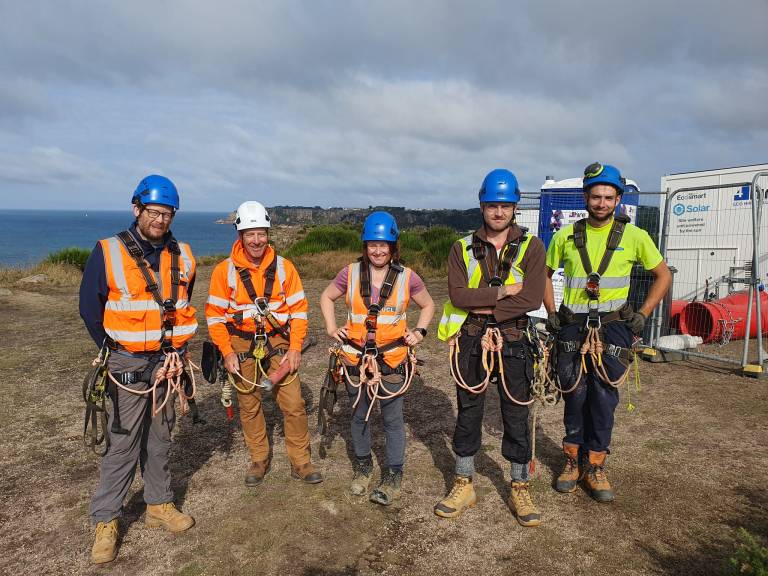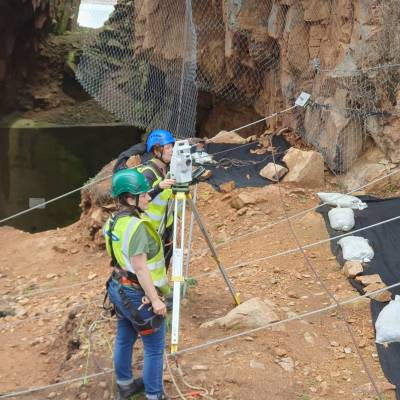Excavations continue at internationally significant Middle Palaeolithic site in Jersey
16 August 2023
Archaeology South-East and partners have successfully completed the 2023 season of excavation at the Middle Palaeolithic site of La Cotte de St Brelade, Jersey, working on the Jersey Heritage funded project to protect, stabilise and investigate this Neanderthal mega-site.

Introduction
Working with colleagues from Wessex Archaeology and the University of Wales Trinity St Davids, archaeologists from ASE have been providing the archaeological expertise in the latest phase of this Jersey Heritage project to protect, stabilise and investigate the site of La Cotte de St Brelade.
Cover photo: ASE’s Dr Ed Blinkhorn (Archaeology South-East), Marc Stirrup (Geomarine), Letty Ingrey (Archaeology South-East), Stefan Bryant (Archaeology South-East) and Jamie Kearns (Geomarine) prepare for their descent by abseil.
History of the project
Since 2010 Dr Matt Pope has helped to lead the La Manche Prehistoric research group (LaMP), a multidisciplinary team of experts working to unlock the prehistoric potential of Jersey. During this time, and with the generous support of island partners Jersey Heritage and the Société Jersiaise, the team have investigated and published on Jersey’s 250,000-year record of human activity and placed it in the context of the now-submerged Ice Age region of La Mancheland.
Since 2014 the LaMP team have been supporting Jersey Heritage in their long-term project to protect, stabilise and investigate the Middle Palaeolithic site of La Cotte de St Brelade, on Jersey’s south-west coast. The site consists of a T-shaped ravine system of partially collapsed sea caves on a granite headland rising 70m above the modern coastline. The site has produced an internationally important record of at least 14 separate periods of prehistoric occupation over a quarter of a million year period, and comprising some 200,000 stone artefacts, the structured use of mammoth bone to create monumental heaps, as well as the fossil remains of Neanderthal people themselves.
The site, which still retains enormous archaeological potential, was determined to be undergoing active erosion during winter storms. In response, Jersey Heritage devised a programme of engineering to make the site safe both for the construction of a protective sea wall, and for the stepped excavation, under archaeological control, of 10m metre high cliffs of Ice Age sediment containing archaeology in order to stabilise them. Excavations in the summer of 2019 initiated a multi-year project funded and managed by Jersey Heritage. Jersey-based civil engineering experts Geomarine oversee site access, safety and assist in technical aspects of reduction at the site. The project represents a challenging collaboration between coastal engineering specialists and archaeologists, aimed at mitigating a direct and accelerating threat from erosion by the sea.
Excavations at La Cotte, 2023
The 2023 season took place in July and early August and saw the LaMP team begin by working with Geomarine surveyors to establish a robust series of survey benchmarks across the site, something that had never been achieved before due to the size and geometry of this challenging environment. As the 2022 season had seen the transformation of the site from an uneven and sloping surface to a flat working area at 23.5m above sea level, the survey allowed for the setting up of a baseline and control sections to direct the methodological excavation and recording of the sediments below.

Letty Ingrey using the total station to survey after one of Dr Sarah Duffy’s photogrammetric surveys of the site
The team then spent the next three weeks carefully reducing the bluff, recording the geology and recovering archaeological remains, in order to create a second step at 22.5m. Excavation is challenging at this potentially hazardous site. The project team access the bluff by abseiling almost 50m under supervision from Geomarine, and then work in harnesses connected at all times to safety ropes. Movement across the site has to be slow and careful, with attention being given at all times to the safety of the team.
The successful completion of the 2023 season saw a further 35 cubic metres of sediment removed from the top of the bluff. Much of the sediment comprised either rubble from the cold periods of the last Ice Age or spoil left behind by previous workers at the site, but towards the north of the bluff we continued to recover artefacts left at the site by Neanderthal people as much as 60,000 years ago. Detailed scientific records and samples were taken and will contribute to the future publication of the project.
Excavations this year have been affected by an unseasonable spell of windy weather which, given the hazardous nature of the site, meant that work was not possible there on two separate days. This allowed time for the team to work with Jersey Heritage’s Curator of Archaeology, Olga Finch, on the careful reorganisation of artefacts recovered from La Cotte de St Brelade over the past 120 years. This important curatorial work is feeding into a programme of on-going analysis of material relating to the last occupation phases by Neanderthals at the site and their possible shared ancestry with some of the first Homo sapiens in the region.

From left to right, Olga Finch (Jersey Heritage), Professor Martin Bates (University of Wales Trinity St Davids), Dr Andrew Shaw (Wessex Archaeology), Jon Dobbie (Wessex Archaeology), Stefan Bryant (Archaeology South-East) and Letty Ingrey (Archaeology South-East)
The team will now spend the autumn writing up the 2023 excavations and preparing for next summer’s season.
Find out more
If you want to learn more about Jersey Heritage’s commitment to the site you can watch their video introducing the project. Dr Matt Pope also recently contributed to an episode of The Ancients podcast on the site and the last 13 years of research by the LaMP team.
 Close
Close

